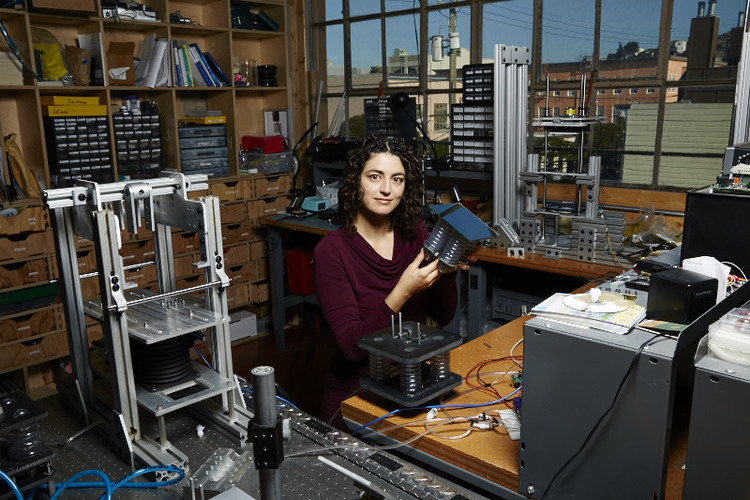
In this season of thanksgiving, ARPA-E is highlighting several awardees who are changing our nation’s energy landscape and challenging the status quo by developing entirely new ways to generate, store, and use energy. These two ARPA-E projects, highlighted below, have the potential to radically improve U.S. economic prosperity, national security, and environmental well-being. We’re thankful that these projects are creating long-term impacts in the energy space: Smart Wires PowerLine GuardianTM Smart Wires, formerly known as Smart Wire Grid, developed a solution for…

October 29, 2015 To wrap up ARPA-E’s spotlight on Energy Action Month, this blog highlights the Agency’s third key mission area of sustainability. ARPA-E is developing a sustainable American energy future by investing in technologies that will increase U.S. energy efficiency, decrease energy-related emissions and help maintain the U.S. technological lead in research and development (R&D). Because ARPA-E Program Directors are constantly exploring potential topics for future program areas, the Agency’s project portfolio spans across and in between various disciplines and…

As part of ARPA-E’s continued spotlight on Energy Action Month, this blog will focus on the Agency’s active role in creating a more affordable American energy future. As one of ARPA-E’s three key mission areas, the Agency is fostering affordability by supporting project teams in developing next-generation domestic energy options that are cost comparable to today's technologies. In addition to funding innovative projects, ARPA-E maintains a Technology-to-Market Program to assist project teams in developing the knowledge and skills they need to prepare for and expedite private-sector deployment…

In continued recognition of National Energy Action Month, our second blog in this series will focus on highlighting ARPA-E’s active role in promoting a more secure American energy future. As one of ARPA-E’s three key mission areas, the Agency promotes security by advancing technologies that will reduce U.S. dependence on imported energy sources, creating more stable and diverse domestic energy production options. As a partner in security, the U.S. military is one of the largest energy consumers worldwide and heavily relies on energy to keep our nation safe by training, moving, and…

October is National Energy Action Month, a full month focused on underscoring how crucial energy is to our national prosperity, security, and environmental well-being. The central mission of the Advanced Research Projects Agency-Energy (ARPA-E) is to accelerate innovations that will create a secure, affordable and sustainable American energy future. ARPA-E advances high-potential, high-impact energy technologies that are too early for private-sector investment. ARPA-E awardees are unique because they are developing entirely new ways to generate, store, and use energy. ARPA-E…

With approximately 173,000 terawatts of solar energy continuously striking the earth, solar energy is the most abundant energy resource available. To put this in perspective, solar energy totals more than 10,000 times the world’s total energy use. Most solar power is in the form of rooftop panels mounted on homes and businesses. Residential solar photovoltaic (PV) capacity surpassed commercial solar PV capacity in 2014 and continues to steadily grow, which can be attributed to a consistent decline in the cost of solar technology and more efficient installation time. However, the Energy…

August 24, 2015 Americans spend a lot of time – and energy – driving and flying. The average U.S. driver logs about 13,000 miles every year. To fuel our commutes and summer road trips, Americans last year consumed more than 136 billion gallons of gasoline, which accounts for 60% of U.S. oil demand and is responsible for a quarter of the nation’s greenhouse gas emissions. On the commercial side, more than 10.3 billion gallons of jet fuel were consumed in 2014 by U.S. airlines alone. With the busiest driving and travel season in full swing, fuel efficiency becomes particularly…

June 25, 2015 Photo: TJ Augustine at his desk at ARPA-E headquarters For the last three years, TJ Augustine has served as a Technology-to-Market (Tech-to-Market) Advisor at ARPA-E, where he has helped prepare breakthrough energy technologies for transition from the lab to the market. He was responsible for leading the commercialization strategy for Reducing Emissions through Methanotrophic Organisms for Transportation Energy (REMOTE), Plants Engineered to Replace Oil (PETRO), and other ARPA-E programs in the area of liquid transportation fuels. Here at ARPA-E, Tech-to-Market…

ARPA-E recently announced 14 new projects funded through the Advanced Research In Dry cooling (ARID) program, which aims to develop low-cost, highly efficient and scalable dry-cooling technologies for thermoelectric power plants in order to reduce water consumption in power generation. At present, a majority of U.S. power plants use water to operate power generation equipment efficiently. However, a combination of growing environmental concern and increased water demand due to population growth is likely to significantly constrain the available water supply that can be allocated to power…

May 21, 2015 Dr. Ellen Williams was confirmed by the United States Senate on Monday, December 8, 2014 as the Director of the Department of Energy’s Advanced Research Projects Agency-Energy (ARPA-E). Prior to joining ARPA-E, Dr. Williams served as the Chief Scientist for BP, a position she has held since January 2010. She is currently on a leave of absence from the University of Maryland where she is a Distinguished University Professor in the Department of Physics and the Institute for Physical Science and Technology. While at Maryland, Dr. Williams founded the…
